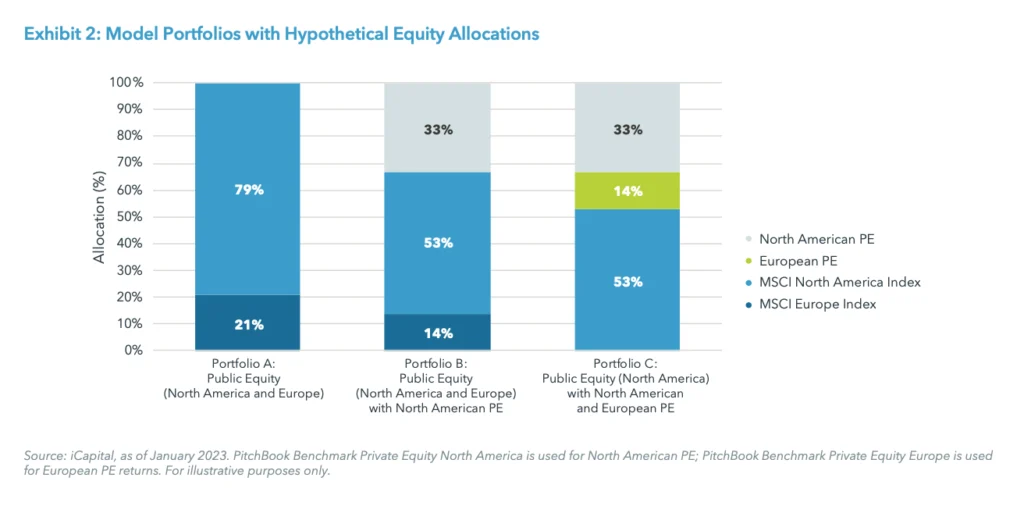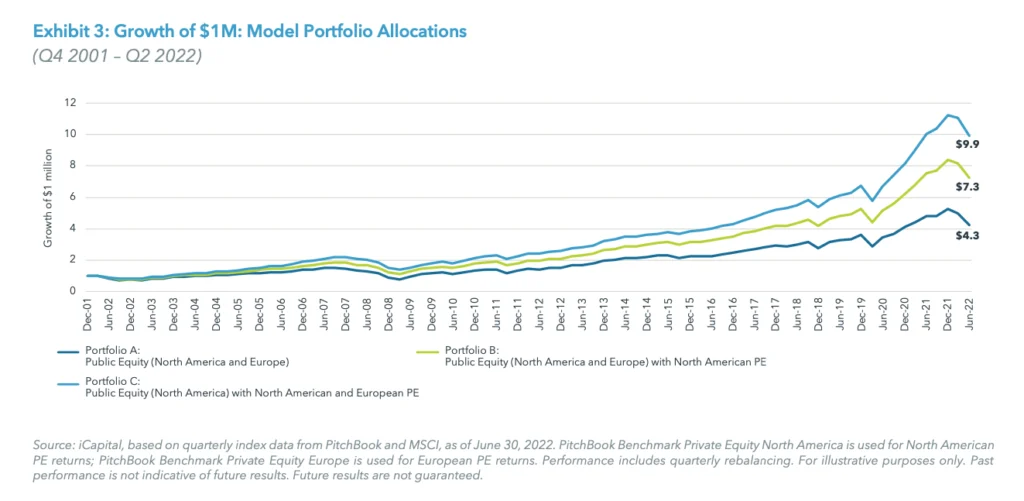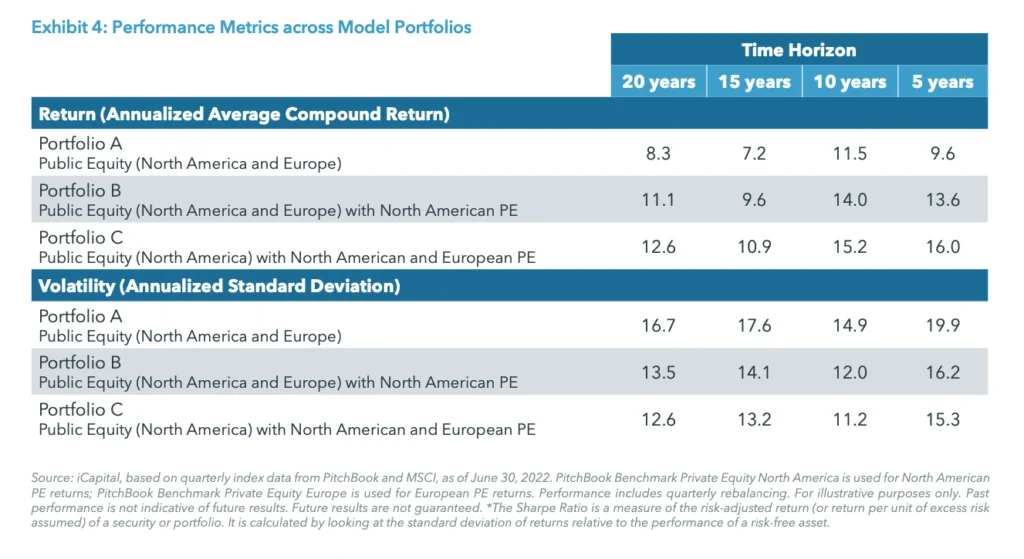A lot has been written about the illiquidity premium and the additional return potential that can be achieved by allocating part of an investor’s portfolio to private assets. But is private markets’ outperformance over public indices comparable across different regions, or should investors proactively diversify their geographical exposure to further increase their return potential? Our analysis suggests that investors should consider an even more aggressive equity allocation to private markets over public markets in Europe than in North America.
When building exposure to private assets, investors globally have traditionally allocated the majority of their portfolios to the North American region, which continues to account for approximately 60% of total capital commitments by high-net-worth individuals (HNWI), compared to lower double-digit percentage exposure to Europe.1
Investing in Europe is often pervaded by the somewhat negative narrative about slower growth leading to lower expected returns, which, in public markets may be true. For the 20-year period ended June 30, 2022, North American public equity indices have substantially outperformed their European peers. The MSCI North America Index has returned an annualized 9.1%, almost double the 5.0% posted by the MSCI Europe Index2 (see Exhibit 1). In the last five years, which saw mostly uninterrupted market growth to year-end 2021, followed by six months of market correction in the first half of 2022, the outperformance of North American public markets over Europe has been even larger, with the MSCI North America Index generating an annualized 11% return, compared to 4% for the MSCI Europe Index.
However, the data reflects a completely different narrative in the private markets. Private equity funds in North America and in Europe have generated somewhat comparable annualized returns, 16.4% and 15.4%, respectively, per annum over the last 20 years.3
These figures suggest that over the last 20 years, European private equity funds have outperformed the region’s public indices by an annualized 10.4%, while North American PE has generated a premium over public equity markets of 7.2% per annum. Investors would have benefitted from private equity’s illiquidity premium over public markets in both regions, with Europe generating a consistently greater return premium than North America over five, 10, 15, and 20 years.4
While it is valuable to compare the performance of public and private equity markets in North America and Europe across various time horizons, we also can use portfolio modeling to understand how the premium from European private equity could have improved portfolio outcomes. To do so, we created and analyzed the performance of three model portfolios representative of three different hypothetical equity allocations (Exhibit 2).5
PORTFOLIO A:
PUBLIC EQUITY (NORTH AMERICA AND EUROPE)
- Public equity-only portfolio with a pro rata allocation based on relative market capitalizations to MSCI North America Index (79%) and the MSCI Europe Index (21%).6
PORTFOLIO B:
PUBLIC EQUITY (NORTH AMERICA AND EUROPE)
WITH NORTH AMERICAN PE
- One-third equity allocation to North American PE, funded pro rata from the public equity allocations in Portfolio A, resulting in a Portfolio B comprised of 53% MSCI North America Index, 33% North American PE, and 14% MSCI Europe Index.
PORTFOLIO C:
PUBLIC EQUITY (NORTH AMERICA)
WITH NORTH AMERICAN AND EUROPEAN PE
- The European public equity allocation is fully utilized to reallocate to the European PE allocation. Portfolio C consists of 53% MSCI North America Index, 33% North American PE, and 14% European PE.
Portfolio A serves as the benchmark portfolio, while Portfolios B and C demonstrate the impact on returns of adding both North American and European private equity to a portfolio.
As Exhibit 3 shows, an investment of $1 million at the end of 2001 would have generated over $9.9 million in Portfolio C over the 20-year period. This is over $5 million more than the public equity-only Portfolio A generated, demonstrating the advantage of adding an allocation to European PE and reducing exposure to the continent’s public markets. Furthermore, the shift to European PE (demonstrated in Portfolio C) would have resulted in 36.8% cumulative higher growth than Portfolio B, which has a one- third allocation to North American PE but none to Europe.
Moreover, looking across five, 10, 15, and 20 year time horizons, Portfolio C, lifted by its European PE exposure, would have consistently generated higher returns than Portfolios A and B (see Exhibits 3 and 4).
Just as importantly, the shift from European public equity to European PE simultaneously reduced volatility across these time horizons (Exhibit 4). While volatility and risk are not necessarily the same thing – the former is simply a measure of the magnitude of movements in both directions over time – lower volatility often contributes to a reduction in measures of risk, such as drawdowns or maximum loss.
Our analysis suggests that investors could further increase their return potential by diversifying private equity exposure across geographical regions. Specifically, the historical data indicates that the return premium generated by European private equity over the MSCI Europe Index is greater than the return premium generated by North American private equity over the MSCI North America Index. As such, there is value to be gained by investing in European private equity, especially if such a commitment is funded out of an investor’s allocation to the region’s public markets.
ENDNOTES
1. Source: “The Future is Private. Unlocking the Art of Private Equity in Wealth Management.” A collaboration between BCG and iCapital, March 2022.
2. Source: PitchBook, MSCI, as of June 30, 2022. PitchBook Benchmark Private Equity North America is used for North American PE returns; PitchBook Benchmark Private Equity Europe is used for European PE returns. For illustrative purposes only. Past performance is not indicative of future results.
Future results are not guaranteed.
3. Source: PitchBook, MSCI, as of June 30, 2022. PitchBook Benchmark Private Equity North America is used for North American PE returns; PitchBook
Benchmark Private Equity Europe is used for European PE returns. For illustrative purposes only. Past performance is not indicative of future results.
Future results are not guaranteed.
4. Source: PitchBook, MSCI, as of June 30, 2022. PitchBook Benchmark Private Equity North America is used for North American PE returns; PitchBook
Benchmark Private Equity Europe is used for European PE returns. For illustrative purposes only. Past performance is not indicative of future results.
Future results are not guaranteed.
5. Please note, the model portfolios are used to demonstrate differences between portfolios and are for illustrative purposes only.
6. Pro rata allocation based on relative market capitalizations in USD of the two indices as of Jan. 31, 2023.
INDEX DEFINITIONS
PitchBook Benchmark Private Equity North America: Consists of those funds within PitchBook’s database that are categorized as North American and fall within one of the following private equity categories: buyout, growth/expansion, mezzanine, restructuring/turnaround, and diversified PE.
PitchBook Benchmark Private Equity Europe: Consists of those funds within PitchBook’s database that are categorized as European and fall within one of the following private equity categories: buyout, growth/expansion, mezzanine, restructuring/turnaround, and diversified PE.
MSCI North America Index: Measures the performance of the large and mid-cap segments of the U.S. and Canada markets. With 713 constituents, the index covers approximately 85% of the free float-adjusted market capitalization in the U.S. and Canada.
MSCI Europe Index: Captures large and mid-cap representation across 15 Developed Markets (DM) countries in Europe. With 425 constituents, the index covers approximately 85% of the free float-adjusted market capitalization across the European Developed Markets equity universe.
IMPORTANT INFORMATION
The material herein has been provided to you for informational purposes only by Institutional Capital Network, Inc. (“iCapital Network”) or one of its affiliates (iCapital Network together with its affiliates, “iCapital”). This material is the property of iCapital and may not be shared without the written permission of iCapital. No part of this material may be reproduced in any form, or referred to in any other publication, without express written permission of iCapital.
This material is provided for informational purposes only and is not intended as, and may not be relied on in any manner as, legal, tax or investment advice, a recommendation, or as an offer or solicitation to buy or sell any security, financial product or instrument, or otherwise to participate in any particular trading strategy. This material does not intend to address the financial objectives, situation, or specific needs of any individual investor. You should consult your personal accounting, tax and legal advisors to understand the implications of any investment specific to your personal financial situation.
ALTERNATIVE INVESTMENTS ARE CONSIDERED COMPLEX PRODUCTS AND MAY NOT BE SUITABLE FOR ALL INVESTORS. Prospective investors should be aware that an investment in an alternative investment is speculative and involves a high degree of risk. Alternative Investments often engage in leveraging and other speculative investment practices that may increase the risk of investment loss; can be highly illiquid; may not be required to provide periodic pricing or valuation information to investors; may involve complex tax structures and delays in distributing important tax information; are not subject to the same regulatory requirements as mutual funds; and often charge high fees. There is no guarantee that an alternative investment will implement its investment strategy and/or achieve its objectives, generate profits, or avoid loss. An investment should only be considered by sophisticated investors who can afford to lose all or a substantial amount of their investment.
iCapital Markets LLC operates a platform that makes available financial products to financial professionals. In operating this platform, iCapital Markets LLC generally earns revenue based on the volume of transactions that take place in these products and would benefit by an increase in sales for these products.
The information contained herein is an opinion only, as of the date indicated, and should not be relied upon as the only important information available. Any prediction, projection or forecast on the economy, stock market, bond market or the economic trends of the markets is not necessarily indicative of the future or likely performance. The information contained herein is subject to change, incomplete, and may include information and/or data obtained from third party sources that iCapital believes, but does not guarantee, to be accurate. iCapital considers this third-party data reliable, but does not represent that it is accurate, complete and/or up to date, and it should not be relied on as such. iCapital makes no representation as to the accuracy or completeness of this material and accepts no liability for losses arising from the use of the material presented. No representation or warranty is made by iCapital as to the reasonableness or completeness of such forward-looking statements or to any other financial information contained herein.
Securities products and services are offered by iCapital Markets, an SEC-registered broker-dealer, member FINRA and SIPC, and an affiliate of iCapital, Inc. and Institutional Capital Network, Inc. These registrations and memberships in no way imply that the SEC, FINRA, or SIPC have endorsed any of the entities, products, or services discussed herein. Annuities and insurance services are provided by iCapital Annuities and Insurance Services LLC, an affiliate of iCapital, Inc. “iCapital” and “iCapital Network” are registered trademarks of Institutional Capital Network, Inc. Additional information is available upon request.
©2024 Institutional Capital Network, Inc. All Rights Reserved. | 2024.01























